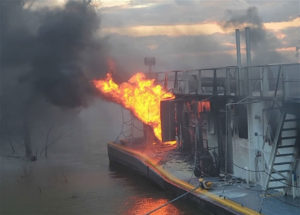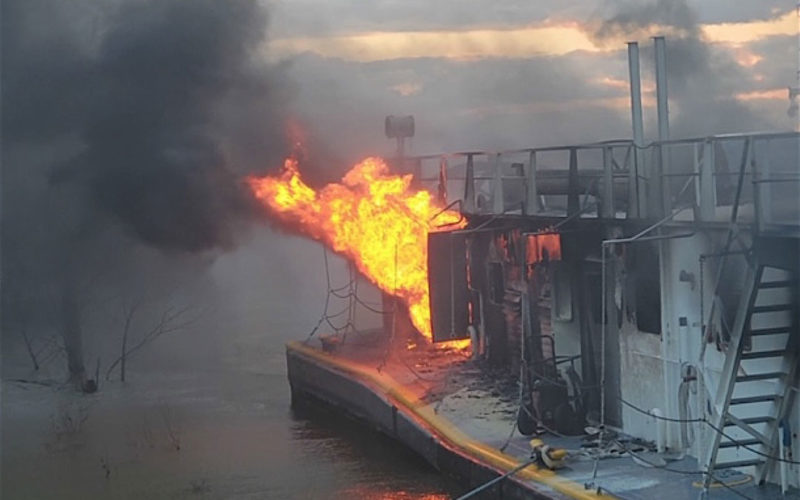
The 140-foot City of Cleveland was pushing 18 barges up the Lower Mississippi River when the captain heard a sound similar to a log hitting a propeller.
Moments later, the port engine stopped and flames erupted from the engine room. The nine crewmembers on the towboat escaped to a barge and were later rescued by a good Samaritan vessel. No one was injured and no pollution was reported.
National Transportation Safety Board (NTSB) investigators attributed the fire, which occurred at about 1600 on Feb. 26, 2020 near Natchez, Miss., to a catastrophic failure of a connecting rod on the port engine. They believe oil and fuel then sprayed from the engine and ignited on a hot surface before spreading throughout the engine space and adjacent rudder room.
“Contributing to the severity of damage to the vessel was the lack of a fixed fire-extinguishing system for the engine room, as well as the loss of electrical power to the single fire pump,” the NTSB said in its accident report.
The 37-year-old City of Cleveland sustained nearly $2 million in damage. Jantran Inc. of Rosedale, Miss., which owned and operated the 6,000-hp towboat, did not respond to inquiries about the NTSB findings. Tracking information indicates the vessel has been idle since the fire.
The fire aboard City of Cleveland closely mirrored an incident aboard another Jantran towboat, Leland Speakes, in February 2018. The NTSB determined “the vessel’s lack of a fixed fire-extinguishing system for the engine room and lack of redundant fire pumps” also contributed to the severity of that fire.
City of Cleveland got underway from New Orleans on Feb. 24 with 15 barges carrying fertilizer and steel, with three empty barges also in the tow. Crew reported the initial leg was uneventful until the captain heard the sound akin to a log hitting a prop.
The situation became serious in a matter of seconds. Wheelhouse crew saw flames coming from the engine room ventilation housings on the upper deck. At about the same time, the engineer looked through an interior window into the upper engine room space and saw it was engulfed in flames. The generator that was running soon stopped and the vessel lost power.
The towboat’s fire pump couldn’t run without electricity. Crew opened the starboard door to the engine room and attempted to use semi-portable extinguishers to fight the fire, but the discharge hose ruptured on the starboard unit. The port unit was inaccessible due to heat and flames.
“With no electrical power available to run the towboat’s fire pump, the vessel adrift in the river and the fire spreading beyond the engine room, the captain ordered the crew to evacuate to the tow’s barges,” the report said.
The towboat Susan K. reached the drifting tow at about 1700 and pushed it to the left descending bank. Another towboat, Jackson Platte, took the nine displaced crew on board at about 1800. City of Cleveland and Jackson Platte crews worked together to fight the fire while Susan K. held the tow in place along the bank.
City of Cleveland’s starboard engine continued running during much of the fire response. The chief engineers from City of Cleveland and Jackson Platte reboarded the burning towboat and ultimately used a pole to reach the fuel shutoff on the governor, the NTSB said. The remote fuel shutoff for the starboard main had failed to shut down the engine. The flames were extinguished at about 1900.
“The ball valve in the fuel line connected to the remote shutoff cable was later found to have been pulled past its closed position,” the NTSB said.
Investigators found extensive damage to the General Electric 7FDL12 port main engine. The right No. 4 piston head and connecting rod clamp were on the floor starboard to the engine, while the left No. 4 master connecting rod lay on the floor with the piston pin bolt missing.
“The initial failure was likely with the connecting rod clamp or the bolt that held the piston pin,” the report said. “Regardless, the force of the driven-loose connecting rods inside the engine was enough to puncture a hole in the side of the crankcase on the port side and eject the piston head through the No. 4 right cover on the starboard side.”
Ignition likely happened soon afterward as hot oil and fuel sprayed from the engine. The fire spread up the port side of the engine room and into surrounding mechanical spaces. The crew quarters within the superstructure were not seriously damaged.
Monthly firefighting drills were held for crew aboard City of Cleveland, but that training had limited effect in the early stages of the fire. The fire pump could not be activated once the generator failed, and the extinguishers were either inaccessible or too damaged to use. Investigators said the extinguishers likely would not have put out the fire.
“The engine room was not equipped with a fixed fire-extinguishing system, nor was it required to be by existing regulations,” the report said. “If City of Cleveland had a fixed fire-extinguishing system in the engine room, as well as a means to close the ventilation and open windows in the engine room from the outside, the fire may have been able to be extinguished.”

